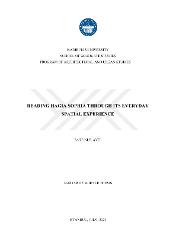| dc.description.abstract | Hagia Sophia was inaugurated in July 2020 as the Hagia Sophia Grand Mosque. With its conversion into a mosque it has been discussed over its political, social, and religious values by states, institutions, and congregations. Relevant professional groups have followed the spatial interventions to the cultural heritage monument. On the other hand, the new place Hagia Sophia transformed into has not been studied much in terms of the spatial program of the site and the experience of the place. This thesis addresses this gap in the literature and explores how Hagia Sophia works as a place in its everyday life. How is Hagia Sophia constructed as a place with its spatial order, management, and visiting rules? How does the new function as a mosque come together with its museum and church pasts? What is the relationship between the mosque that is presented in the official discourse of the conversion and the Hagia Sophia Grand Mosque? How do visitors with different backgrounds and genders, who come with different purposes, experience the place? In this thesis, I aim to provide a comprehensive view of Hagia Sophia after its conversion into a mosque. For this, inspired by Kim Dovey's approach to place, I look at the spatial program and the discursive constructions of place, and the ways its users experience it. First, in order to illuminate the conversion process, I research the official discourse regarding the conversion of Hagia Sophia and analyze the first displays of the monument as a mosque. I also examine the media coverage and reactions to the conversion from scholars, states, and communities. In this research, I conducted a fieldwork between October 2022 and March 2023 using the participant observation method. The fieldwork consisted of site visits at different times, particularly during prayers, and interviews with the visitors of Hagia Sophia. Based on my observations from the fieldwork and the perspectives of the interviewees, I try to explore the everyday life and experiences of this new place. | en_US |
















